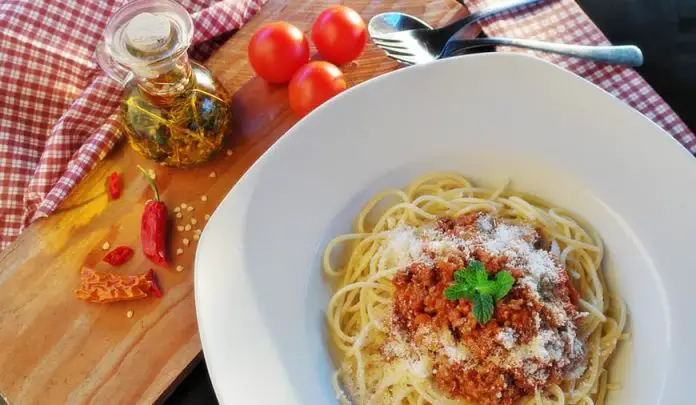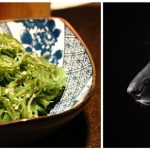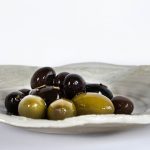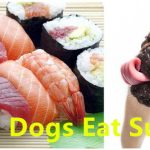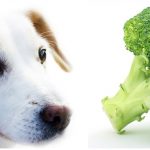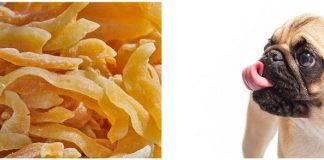Feeding table scraps to dogs is never a good habit. But let’s be honest – most dogs would still eat your leftovers when there is an opportunity. Pasta happens to be a notorious leftover, mainly because it’s also a common staple in most households.
Thing is, many pet owners allow their dogs consume their leftover pasta. Some even enjoy watching their pups vacuuming up a plate of spaghetti in milliseconds.
Do you allow your dog to eat your leftover pasta? Or are you a strict dog parent who does not allow him to consume any table scrap?
First, let’s see if pasta is okay for dogs to begin with.
Can dogs eat pasta noodles?
Yes, since a pasta noodle is just basically refined durum wheat flour mixed with water or eggs. These things should not harm your dog unless he has an allergy to wheat-based foods.
When your pooch is allergic to wheat, he will start itching because food allergy in dogs is often associated with skin and coat complications. When you are pretty sure that the culprit of his hypersensitivity is wheat, take him to a vet to find out whether he should have a wheat-free diet.
Don’t be too concerned about the wheat. There are so many types of noodles out there that will not aggravate your dog’s hypersensitivity to certain types of food.
Rather than the noodles themselves, you should be more worried with the things you add to them. Spaghetti sauce, for instance, is not a wholesome option for doggies.
Although tomato sauce is not toxic for them, the other stuff that goes into it may be harmful. This includes onions, garlic, sugar, salt, and pepper.
The suggest that doggies can eat pasta without sauce. However, most dogs will not really be enticed with a sauce-less pasta. If you have enough time, you can create your own tomato sauce just to satisfy your dog’s craving for spaghetti.
Consider making your own version of a basic tomato sauce. You can find a few recipes on the internet that were created without the use of garlic and onion.
Instead of garlic and onion, you may use red and green peppers to add some flavor to your DIY tomato sauce and you can season it with a bit of ground white and black pepper. You may even use fresh tomato sauce if you prefer it to the canned variety.
If you are planning to share your spaghetti with your dog, better make it the simplest way possible. Since ready-made spaghetti sauce is already loaded with lots of seasonings, it is best to stick to homemade tomato sauce.
Are you excited to make a delicious pasta dish for dog? We compiled the best pasta recipes that are acceptable for a canine’s consumption.
Dog-friendly Pasta Recipes
Is there a pasta noodle specially made for dogs? No, but you can tweak your regular pasta dish so it will be good enough for them. Don’t be afraid to experiment a little. As long as the ingredients are safe for dogs, you should not worry about feeding the dish to your pet. Just remember to feed him spaghetti in moderation.
Did you know that you can create a delicious pasta dish even without seasonings? This one is a tasty treat for dogs although it does not have salt and pepper. This dish is bursting with flavor because of the parsley and dried basil. Here’s how to do it:
- Boil the whole grain pasta and set aside. Compared to regular pasta, whole-grain pasta is healthier because it contains thrice the fiber amount.
- Thoroughly cook the lean ground beef in a separate pan.
- Add the canned tomato sauce, a tablespoon of parsley, and a tablespoon of dried basil.
- Put a liberal amount of the meat sauce on the whole-grain pasta.
If your dog can easily digest dairy, you may add a dollop of cheese on top of the dish. The recommended types of cheese for them are those with low lactose levels. You can either use Ricotta or cottage cheese, both of these having less than 5 grams of lactose per serving.
TV personality Rachael Ray is known for her penchant for dogs. She has her own pet food line and she shares canine-friendly recipes from time to time. This pasta recipe of hers will make your own pup instantly hungry:
- Bring your chicken broth to a boil and add a bit of salt to it. Set aside.
- Make your mini muttballs by mixing a ¾ pound of ground beef with eggs, carrots, cheese, and parsley.
- Drop them into the broth.
- Let it simmer for around five minutes.
- Put the pasta in it until you get your desired consistency.
Ditalini is the perfect choice for small dogs since this pasta is known for its small tube-like size. This tiny tubular pasta is often used in soups and salads or in recipes that call for less pasta.
This veggie-heavy recipe is a nice treat for dogs of all ages. Because it contains diced carrots, celery, red bell pepper, and cooked spinach, there is no way for you to feel guilty about giving it to your own pup. Excited to make some for them? Here’s the recipe:
- Cook half a pound of lean ground beef over medium heat or until it has browned.
- Add a 1/3 cup of carrots, celery, red bell pepper, and chopped spinach. Make sure all the first three veggies were already diced.
- Add a tablespoon of tomato paste.
- Top your pasta with your prepared sauce.
Try making some of these for your dog if he is the type who is a bit of a picky eater and hates vegetables. If he loves spaghetti so much, he might not notice that you added carrots, spinach, celery, and red bell peppers into the dish. You may drizzle his food with a bit of omega 3 oil for a bit of extra goodness.
When you got a heavy-pounder doggie or you have a lot of pets in the house, it matters to cook food that can serve much even without a lot of ingredients. The simplest spaghetti dish we found is this quinoa spaghetti specially created for doggies:
- Cook the pasta according to the package.
- Cook the beets first by bringing them to a boil for around 40 minutes.
- Once the beets are tender enough, drain them and put them in a food processor with two tablespoons of water.
- Combine the beet mixture with ground chicken.
- Put the sauce on top of cooked quinoa pasta.
Both the chicken and the quinoa are excellent sources of protein. A serving of chicken of around 100 grams has 27 grams of protein while a serving of quinoa has as much as 14 grams protein. Beets make this dish more nutrient-dense because of fiber, potassium, and vitamin C content. These sweet and earthy root veggies also balance the flavor of your spaghetti.
Is Pasta a Healthy Treat For Canines?
Browse YouTube and you will find a few videos of dogs in their “Spaghetti Eating Contest”. The sight of canines gobbling down spaghetti as fast as they can makes some dog experts raise their eyebrows.
Given that, is pasta bad for dogs? Pasta has gained a slightly negative reputation in the recent years. There were allegations that pasta is unhealthy because it makes people fat. Was it just another weight loss myth? Should you avoid giving pasta to your dog because it might make him fat as well?
Believe it or not, pasta is not really a fattening food. That is of course, if you consume it in reasonable amounts. A study published in the BMJ Journals suggests that pasta can be a part of a healthy diet without adding the unwanted pounds. Adding pasta to one’s healthy diet should not have an adverse effect on his body weight outcome.
If that is the case with humans, can dogs have pasta as part of a healthy diet? Unfortunately, it is not the same situation with them because a human’s digestive system is not the same as a canine’s one. Dogs can only be given spaghetti occasionally and not regularly.
Conclusion
Dogs can digest carbohydrates and since pasta is carbs, this is a safe treat for them. As with anything, it is important to feed your dog pasta in moderation.
When giving pasta to your dog, remember the rule of thumb: the simpler, the better. You can offer spaghetti sauce to them as long as you are sure it is free from any ingredients that may cause him harm.
For the best dog nutrition advice, seek your vet’s opinion. Your vet knows the best option for them because he knows the animal’s medical history as well as his tolerance to certain foods.






